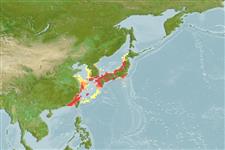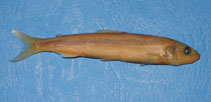Plecoglossus altivelis (Temminck & Schlegel, 1846)
Ayu sweetfish
個人による観察記録の追加 Fish Watcher
| Native range | All suitable habitat | Point map | Year 2050 |

|
| This map was computer-generated and has not yet been reviewed. |
| Plecoglossus altivelis AquaMaps Data sources: GBIF OBIS |
Upload your 写真 and ビデオ
Pictures | Stamps, coins, misc. | グーグルの画像Plecoglossus altivelis
Picture by Islam, Md. S.
Pictures | Stamps, coins, misc. | グーグルの画像Plecoglossus altivelis
Picture by Islam, Md. S.
Chinese Taipei (Taiwan) country information
Common names:
[No common name]
Occurrence: introduced
Salinity: freshwater
Abundance: | Ref:
Importance: minor commercial | Ref: FAO, 2000
Aquaculture: commercial | Ref: Liao, C.-I., H.-M. Su and E.Y. Chang, 2001
Regulations: | Ref:
Uses: no uses
Comments: Native stock extirpated after manmade damage to environment (Ref. 6300). Existing stocks introduced from Japan (Ref. 5193). Cultivated for local consumption and for export to Japan (Ref. 6300). First successful larviculture in Taiwan occurred in 1979 (Ref. 40297). Also Ref. 559.
National Checklist:
Country Information: https://www.cia.gov/library/publications/resources/the-world-factbook/geos/tw.html
National Fisheries Authority:
Occurrences: Occurrences Point map
Main Ref: Liao, I.-C. and H.-C. Lia, 1989
National Database: The Fish Database of Taiwan
Occurrence: introduced
Salinity: freshwater
Abundance: | Ref:
Importance: minor commercial | Ref: FAO, 2000
Aquaculture: commercial | Ref: Liao, C.-I., H.-M. Su and E.Y. Chang, 2001
Regulations: | Ref:
Uses: no uses
Comments: Native stock extirpated after manmade damage to environment (Ref. 6300). Existing stocks introduced from Japan (Ref. 5193). Cultivated for local consumption and for export to Japan (Ref. 6300). First successful larviculture in Taiwan occurred in 1979 (Ref. 40297). Also Ref. 559.
National Checklist:
Country Information: https://www.cia.gov/library/publications/resources/the-world-factbook/geos/tw.html
National Fisheries Authority:
Occurrences: Occurrences Point map
Main Ref: Liao, I.-C. and H.-C. Lia, 1989
National Database: The Fish Database of Taiwan
Common names from other countries
分類 / Names 共通名の | 類義語 | Catalog of Fishes(部類, 種) | ITIS | CoL | WoRMS | Cloffa
> Osmeriformes (Freshwater smelts) > Plecoglossidae (Ayu fish)
Etymology: Plecoglossus: Greek, pleko, plekein = to fold + Greek, glossa = tongue (Ref. 45335).
More on authors: Temminck & Schlegel.
Etymology: Plecoglossus: Greek, pleko, plekein = to fold + Greek, glossa = tongue (Ref. 45335).
More on authors: Temminck & Schlegel.
Issue
All subspecies of Plecoglossus altivelis (Temminck & Schlegel, 1846) are synonymised under the species in Eschmeyer (CofF ver. Jul. 2010: Ref. 84883). Please send references, or more studies are needed.
Environment: milieu / climate zone / depth range / distribution range 生態学
海; 新鮮な水; 汽水性の 底生の; 両側回遊性 (Ref. 51243); 深さの範囲 10 - ? m. Subtropical; 44°N - 23°N
分布 国々 | 国連食糧農業機関の区域 | エコシステム | 事件 | Point map | 導入 | Faunafri
Northwest Pacific: western Hokkaido in Japan southward to the Korean Peninsula, Taiwan and China.
Length at first maturity / サイズ / 重さ / 年齢
Maturity: Lm 27.5, range 30 - 40 cm
Max length : 70.0 cm TL オス/雌雄の選別がない; (Ref. 12218); common length : 15.0 cm SL オス/雌雄の選別がない; (Ref. 35840); 最大記録サイズ: 3.00 年 (Ref. 12218)
Max length : 70.0 cm TL オス/雌雄の選別がない; (Ref. 12218); common length : 15.0 cm SL オス/雌雄の選別がない; (Ref. 35840); 最大記録サイズ: 3.00 年 (Ref. 12218)
簡単な記述 検索表 | 形態学 | 形態計測学
背面の脊椎 (合計) : 0; 背鰭 (合計) : 10 - 11; 臀鰭: 14 - 15; 脊つい: 60 - 63. Pyloric caeca 350-400.
Typical amphidromous fish; appears in near shore from late autumn to spring (Ref. 11230). Found in lakes and rivers, preferring clean river water and can be found the entire river long, from the head to the mouth (Ref. 12218). Ascends the river during March when the temperature is around 10°C (Ref. 12218). Adults spawn in the spring, in the lower reaches of rivers. After spawning, some adults die while others return to the sea. Larvae enter the sea immediately after hatching and remain there during winter, feeding on plankton. In springtime, the young (5-7 cm TL) move upstream to the middle reaches of rivers to feed on algae. Fish (about 6-9 cm) start schooling at the river mouth and are insectivores and eat algae
off small pebbles (Ref. 12218); this is assisted by small leaf-like teeth which are loosely attached to the jaw with two ligaments (Ref. 45181). Those that are ready to spawn (about 20 cm TL) move downstream to the lower reaches of the river. Spawning adults from the sea migrate upstream to the lower reaches as well. Some fish spawn two or three years in succession, others only once (Ref. 9987 & 559). River forms live usually only one year whereas lake forms can live two or three years (Ref. 12218). Reaches maturity at 30-40 cm (Ref. 12218). Highly esteemed food fish. Marketed fresh and consumed fresh, fried and broiled (Ref. 9987).
Life cycle and mating behavior 成熟 | 繁殖 | 放精 | 卵 | 生産力 | 幼生
During spawning some fish go up the river and some fish spawn on the river shoreline above pebbles. Spawns at night and excavates a 10cm (diameter or depth?) pit. Eggs are around 1 mm in size and adhere to the sand or pebbles for 14 to 20 days before hatching. This fish is semelparous and releases eggs many times over a short period each time releasing ~10,000 eggs. Sometimes females that want to spawn but cannot, save their strength, and go to a deep stagnant pool. These females wait until spring before going up the river with young fish. After hatching, the larvae are 6 mm and flow with the water current eating plankton. Juvenile fish will come again to the river in spring. These live in schools. When schools of Plecoglossus altivelis return to their river they guard their territory and eat food (Ref. 12218).
Reproductive mode varies between semelparity and iteroparity. Large females spawn once, while smaller females spawn twice during a two-week interval (Ref. 76896).
主な参考文献
Upload your references | 参考文献 | コーディネーター | 協力者
Masuda, H., K. Amaoka, C. Araga, T. Uyeno and T. Yoshino, 1984. The fishes of the Japanese Archipelago. Vol. 1. Tokai University Press, Tokyo, Japan. 437 p. (text). (Ref. 559)
人間に対する脅威
Harmless
Human uses
水産業: 高い商業の; 水産養殖: 商業; ゲームフィッシュ: はい
より多くの情報
Population dynamics
成長のパラメーター
Max. ages / sizes
Length-weight rel.
Length-length rel.
体長組成
Mass conversion
補充
豊度
成長のパラメーター
Max. ages / sizes
Length-weight rel.
Length-length rel.
体長組成
Mass conversion
補充
豊度
Anatomy
カマ
Brain
Otolith
カマ
Brain
Otolith
Physiology
Body composition
Nutrients
酸素消費
水泳形態
泳ぐ速さ
Visual pigments
Fish sound
Diseases & Parasites
Toxicity (LC50s)
Body composition
Nutrients
酸素消費
水泳形態
泳ぐ速さ
Visual pigments
Fish sound
Diseases & Parasites
Toxicity (LC50s)
用具
E-book | 野外観察図鑑 | Length-frequency wizard | 生活史の基盤ツール | 目的のマップ | Classification Tree
| Catch-MSY |
特記事項
XMLをダウンロードして下さい
インターネットの情報源
Alien/Invasive Species database | Aquatic Commons | BHL | Cloffa | BOLDSystems | Websites from users | Check FishWatcher | CISTI | Catalog of Fishes(部類, 種) | DiscoverLife | ECOTOX | Faunafri | Fishtrace | GenBank(ゲノム, ヌクレオチド) | GloBI | GOBASE | | Google Books | Google Scholar | Google | IGFA World Record | MitoFish | 国のデーターベース | Otolith Atlas of Taiwan Fishes | PubMed | Reef Life Survey | Scirus | SeaLifeBase | 生命の木 | Wikipedia(行く, 検索する) | World Records Freshwater Fishing | 動物に関する記録
Estimates based on models
Preferred temperature (Ref. 115969): 13 - 22.6, mean 19.7 (based on 42 cells).
Phylogenetic diversity index (Ref. 82804): PD50 = 1.5000 [Uniqueness, from 0.5 = low to 2.0 = high].
Bayesian length-weight: a=0.00427 (0.00166 - 0.01096), b=3.06 (2.83 - 3.29), in cm Total Length, based on LWR estimates for this (Sub)family-body shape (Ref. 93245).
栄養段階 (Ref. 69278): 2.8 ±0.16 se; based on food items.
回復力 (Ref. 120179): 高い, 15か月以下の倍増期間の最小個体群 (tm=1; tmax=3; Fec=50,000-100,000).
Fishing Vulnerability (Ref. 59153): Moderate to high vulnerability (48 of 100).




